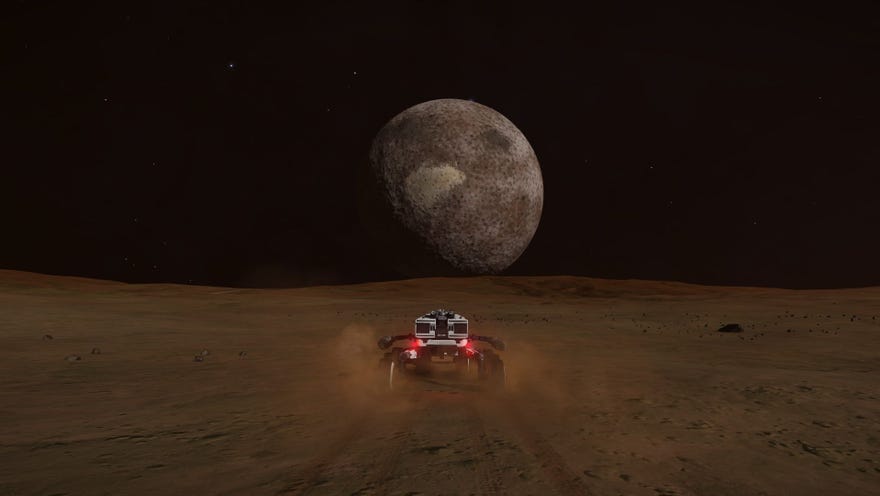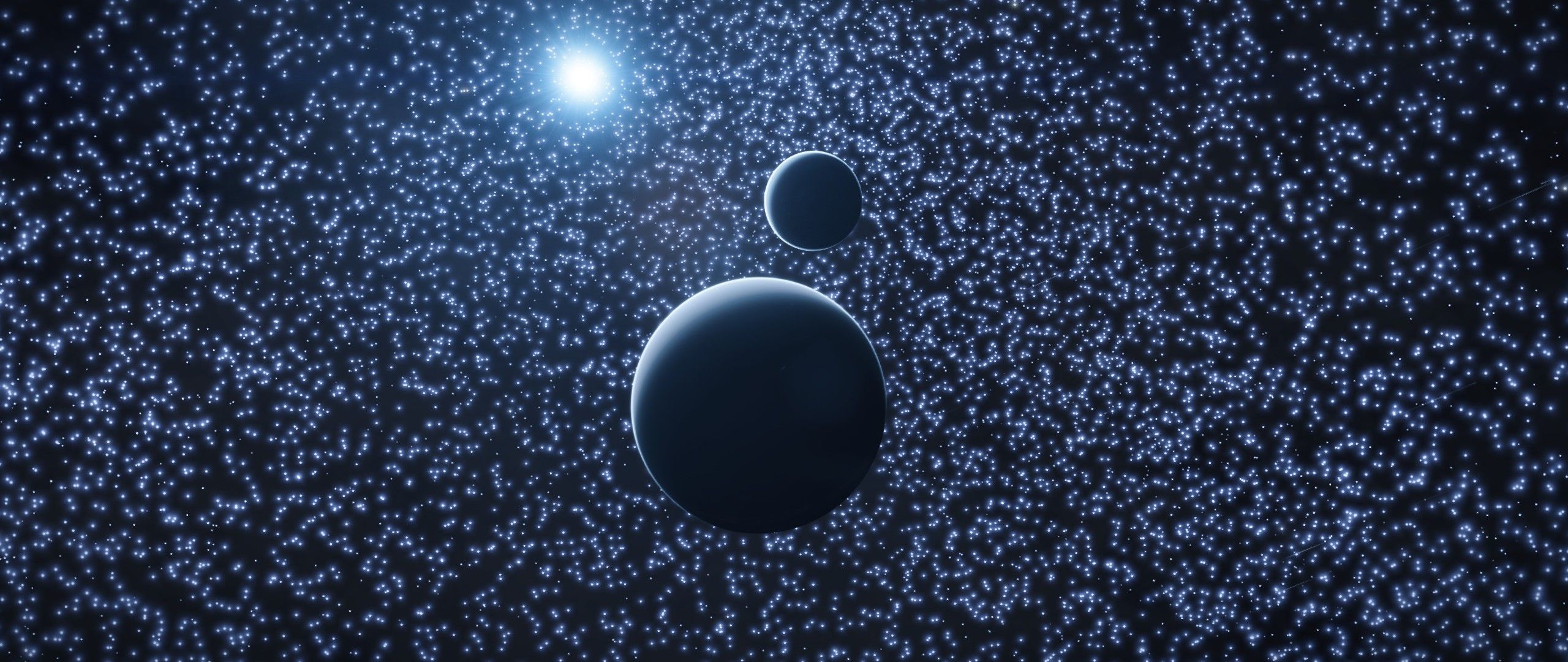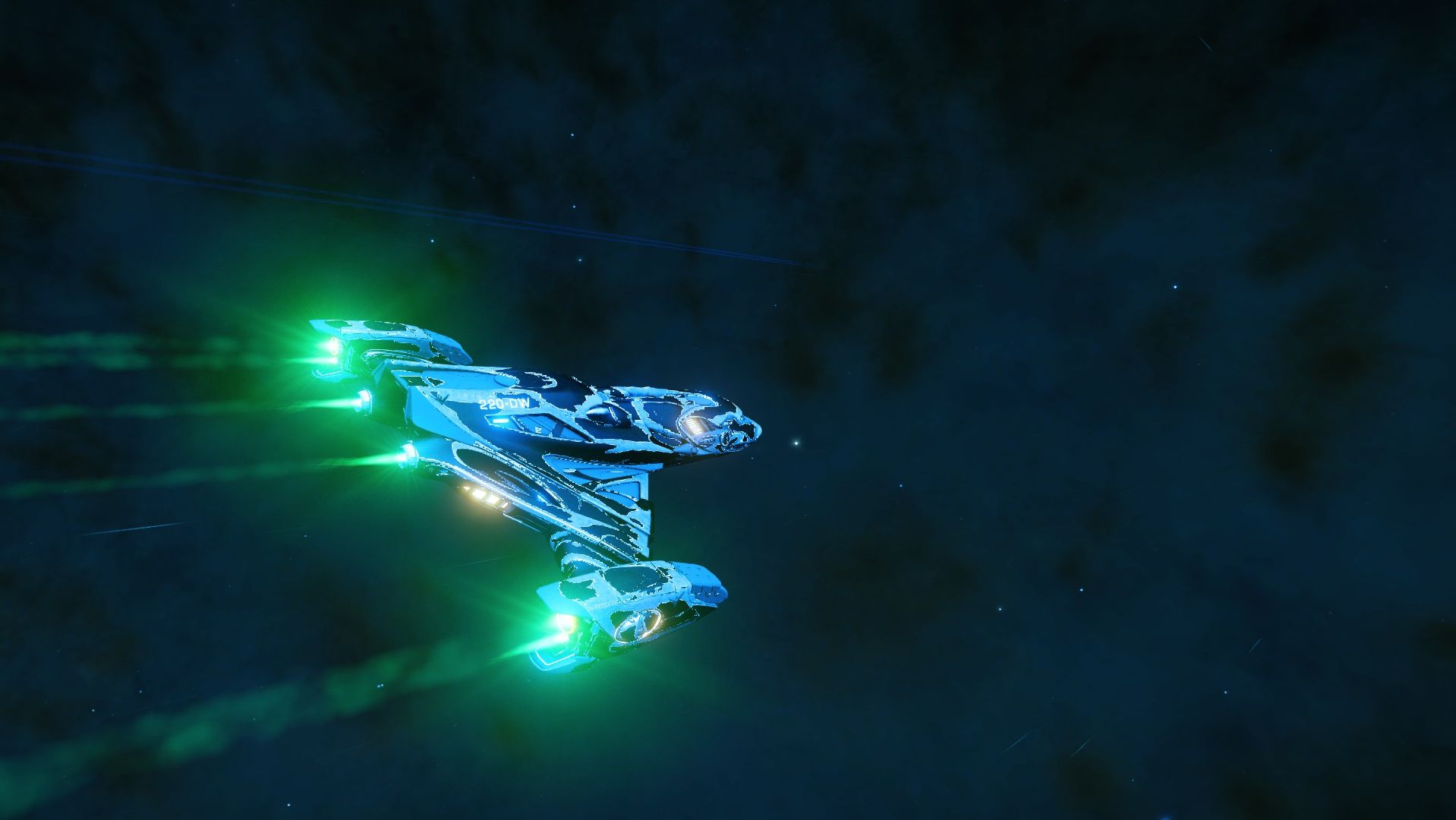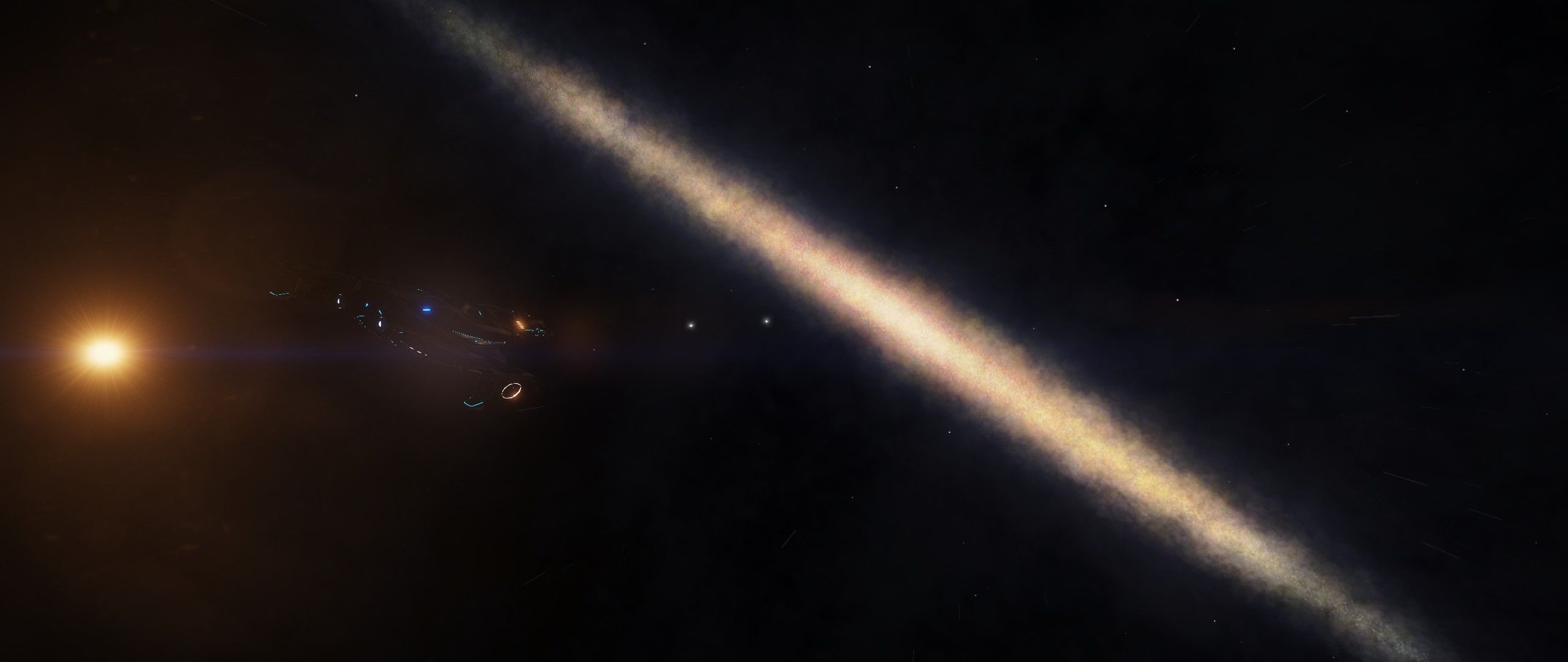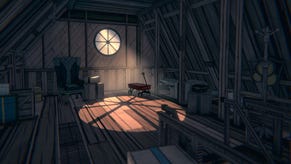At the end of a five-month Elite Dangerous expedition, I looked into the Abyss
The Beagle has landed
My fuel tank might be full, but I can’t say the same for myself. Since leaving the galactic core with such high spirits, my energy levels have plummeted. The journey to the far edge of the Milky Way has become an isolated and grueling gauntlet of star jumps. Jumping from star to star, again and again and again - the repetitiveness is exhausting. I'm no longer even slowing for a cursory scan of a system. Now, I find myself in the Abyss. My galactic map is full of stars, but they are all too distant to reach. I'm so near the end, but with no clear path in sight, wondering if I have come so far only to fall at the final hurdle.
The Distant Worlds 2 expedition came to an end on the 13th June. It was a journey that took thousands of Elite Dangerous players five months to complete as they crossed the galaxy to the remote star system Beagle Point. Over 65,000 lightyears away from Sol, it’s one of the most well-known destinations for any commander looking to earn their exploration stripes. Commanders like me.
Of the 13,615 players that began the journey back in January, the organisers confirmed that 3,747 commanders made it to Beagle Point. That puts the fleet’s attrition rate at around 72 commanders per kilo-lightyear. You can find some interesting statistical breakdowns here. Among the self-destructs and crashes, many more would have considered getting to the centre of the galaxy as a natural stopping point. Cruising by the maw of the supermassive blackhole being no small feat. There were commanders there to lend a hand with the community projects and beyond. Player groups such as the Rock Rats, Fuel Rats, Hull Seals - a whole cadre of researchers, cartographers and scientists all working together. We wouldn’t have a starbase sitting out beside Sagittarius A* without them. Even with all of this support, it was a challenge. We won’t truly know how many succumbed to the isolation, and the affliction players fondly refer to as “space madness”. Others simply lost interest and turned around. In the end, maybe they were the sane ones.
But I carried on. The onward journey from Sagittarius A* was no different to much of the trip so far. Commanders were riding high on a job well done. We’d achieved one of the expedition’s primary goals and constructed a safe-harbour 25,899 lightyears from Sol. There was still plenty to see as we pushed out into the far side of the Milky Way.
En-route to Waypoint 8 (the trip is separated into checkpoints by the organisers) I stopped at the Crown of Ice, a moon in the Phipoea WK-E d12-1374 system, which has some extreme topography on its northern pole. This includes a large mountain range which reaches up towards the stars, but the planet also hosts deep and narrow canyons running through its surface. I steered clear of them. The Imperial Clipper is a relatively wide ship due to its wing-span and I didn’t fancy becoming wedged in an icy crevice, until the heat death of the universe. The Roisin Dubh and I have been through too much at this point, I couldn’t bear ordering my travel companion to self-destruct.
Further along the route there was the Black Giants Nebula. This nebula has no star and instead forms around a black hole. This means that the large gas giants that populate the system always appear dark against the purple backdrop.
Then it was onto Breakthrough Echoes, where there’s a gas giant with not one, but three Earth-like worlds orbiting it. These being the most sought after and valuable type of planetary body, Breakthrough is a rare find.
The route between waypoints 8 and 9 was much the same, although the distances between stars seemed to be getting longer, while the points-of-interest became scarcer. This leg of the journey ended at Cerulean Tranquility. A lovely resting spot within a massive crater, the sky is bathed in a soft purple while a ringed planet floats lazily across the horizon. It was probably the last time I felt anything approaching tranquil on my journey.
Out here in the arse end of space is the last place you’d expect to be troubled by petty things like permits. I’d somehow forgotten that the galactic governments of Elite’s universe possess the longest roll of red tape in existence. This comes in the form of the Bleia Permit Zone. Five large sectors of star fields are permanently closed off from travel (there’s been no official reason given to why these areas are inaccessible - they may have been cordoned off for future content by Frontier, the game's makers, but for now it remains a mystery). No one’s permitted in or out and our route took us through these sectors, zig-zagging between gaps in the banned systems. To make matters worse the ship’s route plotter isn’t smart enough to find an optimal path through the permit maze on its own, so each part had to be mapped manually section by section. It’s enough to make a good commander weep.
Try as I might I couldn’t find a way through. Even with all of the directions afforded to me by three-dimensional space, the way ahead was barred. I was in a knot of dead ends. I’d wasted enough time trying to get through to no avail. I had a choice to make. I decided to bypass the whole region and go around the damn thing. An inelegant solution perhaps. It added hundreds (and I mean hundreds) of extra jumps that took me off course while I circumvented the red tape fields. The maze had defeated me, but I pressed on dejectedly.
I have a lot of time for Elite Dangerous (710 hours and counting to be precise). It helps me unwind after a stressful day and I’ve always found it easy to give myself to its space odd-jobs. Whether I’m hauling industrial equipment or tinkering with my ship’s internals to get a little more speed out of it. I can set the pace. Like the game’s tagline says, I blaze my own trail. It’s not a game I recommend to everyone and not without its flaws, but I’ve heard it said that Elite’s biggest barrier is the grind. Oh you sweet children, how I envy your ignorance. For I have seen the true face of the Grind. And I have wept before its terrible majesty. At the far end of the galaxy I realised the truth. I embraced that I will grind whatever grist the cosmic mill requires.
The part of the galactic map known as the Aphelion was where the weariness really set in. This trip had turned into actual work by now, my podcasts had dried up and my mind was beginning to wander. Here is what the organiser’s had to say about the Aphelion regions I now found myself in:
“The Aphelion regions are a vast stretch of the galaxy that little is known about, with few points of interest to break up the monotony of the hyperspace grind. It is here where fleet attrition will be at its highest.”
There were no more basecamp meetups and I’d fallen too far behind even if there had been. It was just the void and I. All I did was jump. Again and again for hours. I’d only stop for a cursory scan every now and then. The number of photos I was taking plummeted. Like I told the ship’s computer during one of our one-sided conversations, I had one laser focused goal. Get to Beagle Point.
Then I hit the Abyss.
Now, space in general is an abyss. It’s just a load of, well, empty space. The Abyss is even emptier than the rest. It’s the gap between the galaxy’s two northernmost spiral arms. An extraordinarily sparse star field. It’s the final, loneliest and most hazardous part of the journey. An abundance of old and burnt-out stars means that even if you have the jump range to navigate it, you need to manage your fuel effectively and keep a close eye on the star map. Or you can easily find yourself cut off from a viable fuel source.
I couldn’t get a direct route to Beagle Point plotted. My mapper kept failing at around 80% plotted. I knew it was running into stretches of space greater than my current jump range. I’d stocked up on certain raw materials that could be synthesised and stuffed into my petrol tank to give my jump range a boost. This had to be done manually, one jump at a time, and it was a finite resource. The end was in sight and I set off to finish the journey. I certainly started strong. I was studying stars and plotting bite-sized routes. Then I had to use a boost. Then I made a couple of more jumps before using another boost. Then another. Before long I couldn’t move without my extra chemical kick. Then the panic started to set in. My limited stash of spaceboost-juice was running out while the odds of failure increased. Compared to the brightness of the galactic core, the lack of stars out on the outer edge really was striking and I considered it for a time. I wasn’t going to blow it here at the end. So like a hero I turned around and crawled back to the shores of the Abyss.
What was I going to do? I could have travelled further along the arm to a place where the gap between the two spirals was smaller and more dense with stars. Thanks to the Bleia Zone detour and the boring void of the Aphelion this idea was discarded almost immediately. The thought of another detour was too much to bear. Every commander has a breaking point and I knew I’d find mine out there if I took that path. So I stepped away from my flight stick and looked to other players for help. Or at least their maps.
People have been making their way to Beagle Point for years. It’s remote, but at the same time it’s a well-trodden path. I found my answer at Cho Thua SB-W c15-1. The Smuggler’s Path is a 375 waypoint route plotted and recorded by Commander Karaya. One of several known routes across the Abyss, no jump exceeds 33 light years. A distance my ship could comfortably cover. To give myself the best chance I filtered out the star types I knew I couldn’t use to refuel and set off one last time.
After battling the Abyss, an unwieldy route plotter that did its best to get me stranded, and the oppressive boredom that set in during the final weeks, I finally set the Roisin Dubh down at Beagle Depot on the edges of known space. It took some time for it to set in that I’d actually reached the end. I couldn’t quite believe it. I’d gone to bed a few nights with visions of me jumping into a system wedged between three suns and vaporising. It was the 19th of May, and I looked across a dark expanse at a galaxy I’d left behind. I’d even arrived with 88% of my hull still intact, nothing worth troubling the good people of the Hull Seals about (although it’ll be a long journey back). I sat on that moon and let the relief wash over me. I can proudly say I’m among the daring few that reached the conclusion of Distant Worlds 2.
This has undoubtedly been the most amount of work I’ve put into any game. Some of you might baulk from the sheer time commitment it demanded from its participants. It was touch and go by the end, but I don’t regret it for a second. I’ve seen the sights, made some discoveries and after all of the screenshots I’ve taken, I think I might even look into this whole photography thing a little more in my own time.
Elite Dangerous, like most games is about systems and mechanics for players to learn and master. This can often be comforting after your daily dose of cold reality, where best-laid plans can go up in smoke. Events like Distant Worlds 2 are something else though. It’s grand and personal all at once. If I can dedicate myself to something like this, who’s to say that energy and determination can’t be carried forward? It might be a game, but we all need the little victories to help us on our way. I blazed my own trail from Pallaeni to Beagle Point and now there’s a route with my name on it. The only question left to ask is: what’s next?
This is the Roisin Dubh signing off. Fly dangerous, everybody.
